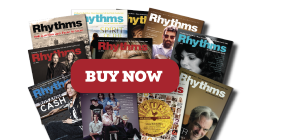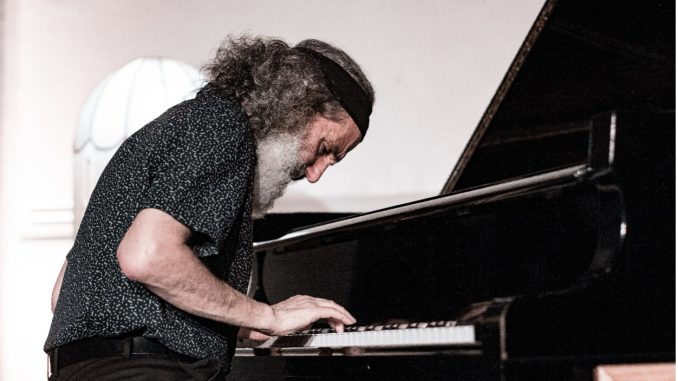
By Des Cowley.
Rhythms Magazine is a broad church, covering everything from blues to jazz, world to folk, and beyond. But it’s fair to say it doesn’t generally spend much time, if any, looking at classical music. Unlike those aforementioned genres, classical tends to come with its own specialized terminology, its own coverage. But, at the end of the day, music is music, and there’ll always be genre-jumping artists who go against the grain, refusing to be pigeon-holed into one category or the other. Consider Keith Jarrett, adept at playing extended solo improvisations and interpreting Bach, Handel, or Shostakovich. Or Chick Corea, whose near-to-final album embraced the music of Mozart, Chopin, Scriabin, as well as Monk and Bill Evans.
One such genre-hopper is Sydney-based pianist Mark Isaacs, whose extended career has seesawed back and forth between jazz and classical. Now in his sixties, he’s been composing and playing music for almost as long, having taken up piano at age-five. Possessed of perfect pitch, he was improvising jazz standards by age-nine, and performing his own classical concerto on Australian television a few years later.
There have been numerous milestones since then, including his brilliant trio album Encounters (1991), recorded with Dave Holland and Roy Haynes; Elders Suite (1997), recorded with the late trumpeter UK Kenny Wheeler; and his several Resurgence Band outings, featuring James Muller, Brett Hirst, Matt Keegan and others. Amongst my favourites is his ambitious cycle of solo improvisations The Elements, released as a four-CD box set in 1996.
While Isaacs has never gone away, it feels to me that he’s been having something of a career resurgence of late. In 2020, a year most of us spent in lockdown, he released no fewer than five recordings, traversing considerable musical terrain: an extended suite for piano and soprano sax, recorded with saxophonist Loretta Palmeiro; a retrospective album of his film scores; an improvised solo piano album Forgotten Fields; and an album of solo piano interpretations of Chopin, Debussy, Satie, Poulenc, and others.
Some might consider such output deserving of a well-earned breather, but Isaacs has, more recently, set himself new challenges, recording his Symphony No. 2, with the Czech National Symphony Orchestra in 2024, and making his first foray into pop music with a cycle of six songs – for which he wrote both music and lyrics – recorded with Australian singer Deborah Dicembre.
Isaacs’ first symphony – commissioned for the Queensland Symphony Orchestra – was written in 2013, shortly after he’d received news of his father’s terminal cancer. Understandably, the music betrays an elegiac air (the symphony was dedicated to his father). Distinguished conductor and pianist Vladimir Ashkenazy was a fan, but advised Isaacs to strive for a more optimistic feel for his second symphony, advice he’s taken on board.
The writing of his Symphony No. 2 – it was completed in 2017 – was funded by Creative Australia. But composing a symphony, and having it performed, are two different things. While it was anticipated it would be programmed by an Australian orchestra, that turned out not to be the case. Isaacs’ submissions to administrators of local orchestras mostly received lukewarm responses, or were entirely ignored. He considers it a sad state of affairs. If he, as an established composer, comes up against closed doors, how much harder must it be for emerging artists?
Nevertheless, Isaacs remained resolute, and, via a colleague, he was introduced to the Czech National Symphony Orchestra (CNSO). The Orchestra is highly regarded, added to which the financial costs of working and recording with the CNSO turned out to be significantly lower than working with local orchestras. After receiving top-up funds from Creative Australia, Isaacs travelled to the Czech Republic, conducting and producing the sessions himself, and forgoing fees – on top of which he contributed his own funds – to complete the project.
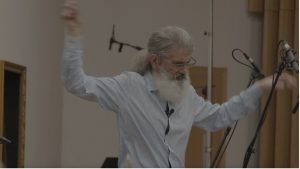
When I ask Isaacs about his experience of working with the CNSO, he confesses to some prior trepidation: “Although I have conducting experience, it hasn’t been a regular part of my career, and my symphony is particularly demanding to conduct. So, I prepared rigorously. In the end, it went very well. The orchestra was musically warm, highly skilled, and came to grips with my challenging writing quickly.”
While Isaacs was exposed to the dissonant music of post-war composers like Stockhausen and Boulez as a teenager, and later at university, he tends to steer clear of their musical directions. He acknowledges their music opened new vistas for him, but equally feels there is something missing, finding it too passionless. For Isaacs, such music “can feel like an exquisite musical mime: gestural, textural, with a kind of overlaid narrative arc. But the absence of melody—hummable, singable melody—and functional harmony (what we’d call chord changes in jazz) is, for me, a bridge too far.”
Instead, Isaacs derives inspiration from a range of 19th and early 20th century composers, citing Chopin, Sibelius, Prokofiev, Rachmaninoff, Stravinsky, Elgar, Vaughan Williams, Bartók, Strauss, Wagner, William Walton. For his three-movement Symphony No. 2, he concedes “there’s a William Walton influence in it, and also a Mahler homage: the second movement is an Adagietto using Mahler’s famous instrumentation of strings and harp – though I added celesta. Walton was also a film composer, and I used to write orchestral film music, so I allowed some of that cinematographic ‘adventure music’ sound world to creep into parts of the brisk outer movements, with some influence from John Williams, who was a formative model in my early film composing days.”
Isaacs’ Grace City EP, featuring singer Deborah Dicembre – and recorded concurrently with his second symphony – has furnished an unexpected twist to his career. He’s written songs before – including lyrics – from an early age, but he admits that Grace City “marks my major debut in this area, as songwriter, producer and pianist/keyboardist.” With the added strings of the Czech National Symphony Orchestra, he grants he “had a great team—not just a wonderful singer and excellent studio musicians, but also people on the production side who’d worked with The Beatles and George Martin.” What’s most surprising is that its unadulterated pop, boasting lush arrangements, catchy themes, melodic hooks. But to my mind, it’s the ballads, like ‘Alice’, that stand out, its verdant strings and euphonic piano recalling the musical language of Bernstein or Sondheim.
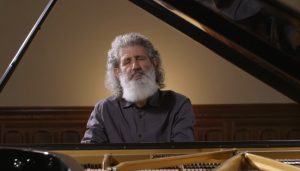
Isaacs’ presence on the jazz scene seems to have taken a back seat of late, but he argues this is just a surface perception, and that across his half-century career “I’ve been continuously engaged in both jazz and classical music.” Perhaps the biggest shift has been his deliberate choice, in recent years, to cease fronting a jazz band: “While I’ve continued to do jazz-based improvisational projects, they’ve been either solo piano or in duo with [saxophonist] Loretta Palmeiro. I don’t miss running a band at all. Although not doing so does cost you visibility in the jazz world—because that world tends to centre identity around groups with bass and drums—I find it liberating.”
The decision has freed up significant time for individual practice for both classical and improvisational music. For now, there are no regrets: “I’m not saying I’ll never play in a group again, but it’s a very low priority for me right now.”
Another decision Isaacs made was to forgo making CDs, though he acknowledges that was more out of necessity than choice: “Although I did make a couple of CDs in the last five years, my most recent releases have been digital-only. This has significant advantages: there are no manufacturing overheads, and once the audio is mastered, it can be released worldwide at no cost. Digital formats also allow for shorter-form projects, including singles and EPs—even in classical music—freeing me from the constraints of having to fill an entire CD.”
A few years back, I caught Isaacs at Birds Basement in Melbourne. His concert of solo improvisations (he prefers the term extemporisations) was nothing short of revelatory, possessed of the sort of ornate and majestic musical qualities we routinely associate with an artist like Keith Jarrett. From a purely selfish perspective, I wish he’d focus more on that aspect of his work. But, for now, it’s clear he’s happy doing what he’d doing. When I broach next projects, he speculates that “it would probably be a recording—and music video—of my interpretations of Chopin’s ‘Four Ballades’. I’ve been practising them four hours a day, seven days a week, for a year now, and I think I need another six months before I’d be ready. But honestly, I’m happy just doing it for myself. Like Everest, they’re there.” It’s an attitude that points to his exacting nature, and one that manifests a restless and searching vision.
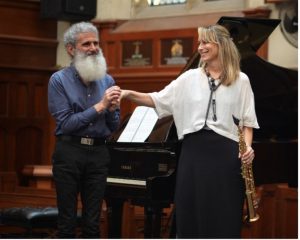
In February this year, Isaacs presented the world premiere of his Sonata for Soprano Saxophone and Piano, performed with Loretta Palmeiro at St Stephens Uniting Church in Sydney (it can be viewed online). It’s a remarkable piece that seemingly straddles classical and jazz. As Isaacs says: “To me, it’s all music—jazz and classical are closely interrelated forms in the Western tradition. Of course, the main difference lies in the presence or absence of improvisation.” There it is again, that simple maxim: music is music. As with artists like Keith Jarrett or Chick Corea, it’s an ethos Isaacs wholeheartedly embraces.

